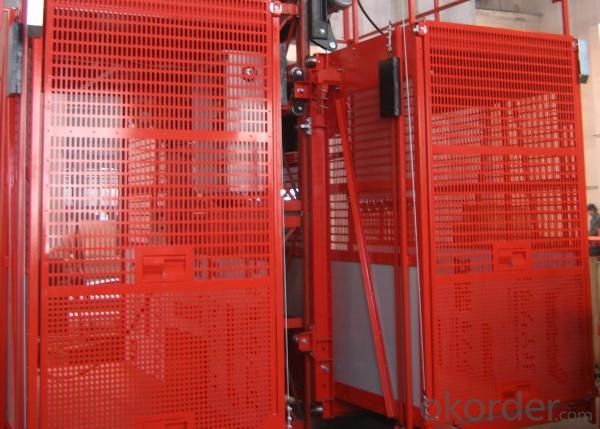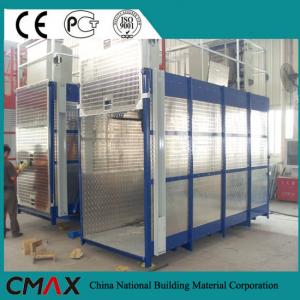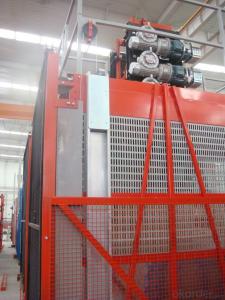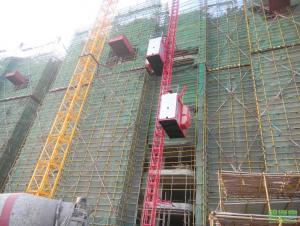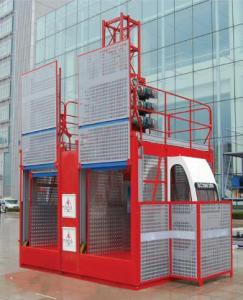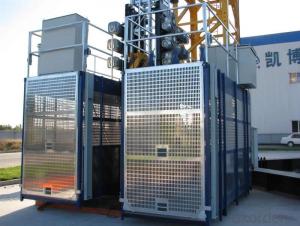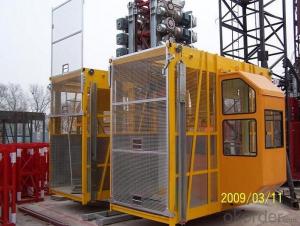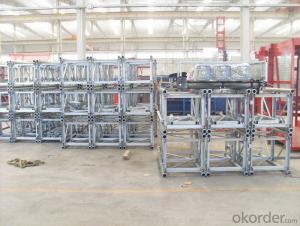Building Hoist SC200
- Loading Port:
- China Main Port
- Payment Terms:
- TT or L/C
- Min Order Qty:
- 1 Set set
- Supply Capability:
- 90 Sets Per Month set/month
OKorder Service Pledge
OKorder Financial Service
You Might Also Like
Description of CMAX BUILDING HOIST SC200/200
The Construction Hoist is set up with frequency conversion and twin cages. Every cage has three suits of independent driving mechanism.With the technology of frequency conversion the construction hoist driven by rack and pinion can speed up and slow down steadily. It has traits such as:
1. Starting and braking are steady with no pounding.
2. The lifting speed can be controlled.
3. Starting current is lower than rated current.
4. The mechanical wear and tear is reduced evidently.
5. Power saves efficiently.
Specifications of SC200
Building Hoist Lifting capacity: 2,000kg
Building Hoist Lifting speed: 33, 0 to 60m/min (VFD + PLC), 0 to 90m/min (VFD + PLC)
Building Hoist Maximum lifting height: 300m
Building Hoist Motor type: Chinese motor or SEW motor
Anti-drop safety device with our patent
Building Hoist Cage size:
Recommended size: 2.0 x 1.0 x 2.5, 2.5 x 1.3 x 2.5m
Mast section: 450X450X1508MM/ 650X650X1508MM, hot-dipped galvanized or painted
Anchor distance: 6 to 9m, hot-dipped galvanized or painted
The whole machine can be designed according to customized specific requirements
Packaging & Delivery
Package: container
Delivery time: 20~25days
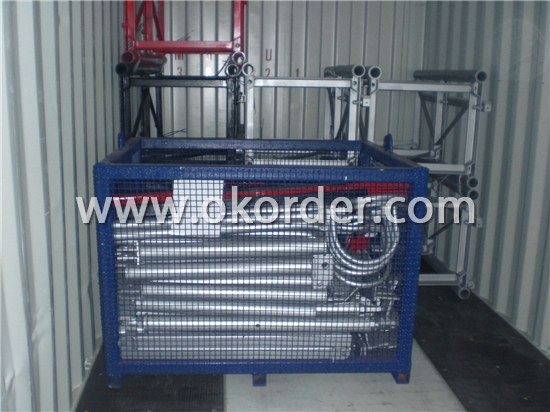
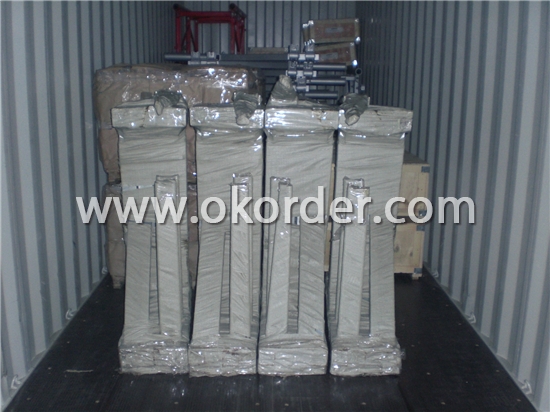
- Q: Is it possible to utilize a building hoist for lifting materials during demolition projects?
- <p>While a building hoist is typically designed for construction purposes to lift materials and personnel, it is not advisable to use it for demolition work. Demolition involves hazardous conditions with falling debris and unstable structures, which can compromise the safety and integrity of the hoist. Instead, specialized equipment like wrecking balls, hydraulic shears, and cranes are more suitable for demolition tasks. These are engineered to handle the heavy loads and unpredictable conditions associated with breaking down structures safely.</p>
- Q: A building hoist is a mechanical device used in construction to lift materials and sometimes workers vertically. It is essential for the efficient movement of materials in high-rise construction.
- <p>The function of a building hoist is to facilitate the vertical transportation of materials, equipment, and sometimes workers within a construction site. It is particularly useful in high-rise buildings where manual lifting would be inefficient and unsafe. A building hoist allows for the rapid and safe movement of materials, reducing labor costs and improving construction speed.</p>
- Q: This question asks about the measures taken to guarantee the safety and reliability of lifting equipment prior to its use in construction.
- <p>To ensure that lifting equipment is safe and reliable before using it in construction work, several key steps must be taken. Firstly, regular inspections and maintenance are crucial to identify any potential issues or wear and tear. Secondly, all equipment should be thoroughly tested and certified by qualified personnel to meet safety standards. Thirdly, proper training for operators is essential to ensure they understand how to use the equipment safely. Additionally, having a comprehensive safety plan in place, including emergency procedures, can help prevent accidents. Lastly, using equipment from reputable manufacturers and ensuring all components are in good working order are also vital for maintaining safety and reliability.</p>
- Q: What is the main function of the construction elevator safety guard
- When the cage is unexpectedly overspeed, the cage will be stationary on the rail frame and cut off the power supply to ensure the safety of personnel and equipment.
- Q: How does the driver of the construction elevator do the search for a sudden power failure
- There are clear rules for the safety of construction machinery (JGJ33-2001). 6.12.17 when the elevator is running in an existing abnormal condition, it should stop immediately and take effective measures to reduce the cage down to the ground level, and keep running after the failure. When the electric is out of control in operation, the stop button should be pressed immediately. The stop button is not allowed until the failure is ruled out. 6.12.20 when elevator in the operation of the midway stop due to power outages or other reasons, can be manually, the end of a motor brake electromagnet manual release slowly shake handshandle pull outward, slowly slide down the ladder cage, ladder cage fall shall not exceed the rated speed, manually drop must be conducted by professional maintenance personnel manipulation.
- Q: This question asks about the different types of hydraulic cylinders that are utilized in lifting equipment.
- <p>Hydraulic cylinders used in lifting equipment can be categorized into several types based on their design and application. The main types include: single-acting cylinders, which have one port for fluid and rely on the load or a spring to return; double-acting cylinders, which have ports on both ends and can extend and retract through fluid pressure; telescopic cylinders, which consist of multiple stages that can extend sequentially for greater reach; and rotary hydraulic cylinders, which provide a combination of linear and rotary motion. Each type is chosen based on the specific requirements of the lifting task, such as the need for speed, force, and control.</p>
- Q: Is it possible for a single lifting device to simultaneously lift multiple objects with varying weights?
- <p>Yes, a single lifting device can be used to lift multiple objects at once with different weights, provided the total weight does not exceed the device's lifting capacity. The device must be designed to handle the combined weight and ensure even distribution of the load. Safety measures and proper securing of the objects are crucial to prevent accidents. It's important to follow the manufacturer's guidelines and never exceed the maximum load capacity to avoid damage or injury.</p>
- Q: How large a leakage protector is used for the construction elevator
- If it is 33KW, direct start, single cage, 160A, leakage action current 50ma-75ma, movement time 0.1 s, electrical machine leakage protector. The best.
- Q: What is the highest weight a building hoist can safely lift?
- <p>The maximum load capacity of a building hoist can vary significantly depending on the specific model and design. Generally, capacities range from 500 kg to 3,000 kg or more. It's crucial to refer to the manufacturer's specifications for the exact load capacity of any given hoist. Overloading a hoist can lead to accidents and damage, so it's essential to operate within the specified limits.</p>
- Q: Explain the key differences between electric and pneumatic lifting equipment in a few sentences.
- <p>Electric lifting equipment is powered by electricity and offers precise control, high efficiency, and is suitable for heavy-duty applications. Pneumatic lifting equipment, on the other hand, is powered by compressed air and is known for its simplicity, safety, and lower cost. It is often used in environments where electrical equipment might be hazardous, such as in the presence of flammable gases or dust. Electric systems can handle heavier loads and provide more precise control, while pneumatic systems are more resistant to overload and offer a fail-safe mechanism in case of air pressure loss.</p>
1. Manufacturer Overview
| Location | Jiangsu,China |
| Year Established | 1990 |
| Annual Output Value | Below US$1 Million |
| Main Markets | Mid East;Southeast Asia;South America |
| Company Certifications | ISO 9001:2008; |
2. Manufacturer Certificates
| a) Certification Name | |
| Range | |
| Reference | |
| Validity Period |
3. Manufacturer Capability
| a) Trade Capacity | |
| Nearest Port | SHANGHAI |
| Export Percentage | 1% - 10% |
| No.of Employees in Trade Department | 300 |
| Language Spoken: | English;Chinese |
| b) Factory Information | |
| Factory Size: | Above 300,000 square meters |
| No. of Production Lines | Above 15 |
| Contract Manufacturing | OEM Service Offered;Design Service Offered |
| Product Price Range | Average |
Send your message to us
Building Hoist SC200
- Loading Port:
- China Main Port
- Payment Terms:
- TT or L/C
- Min Order Qty:
- 1 Set set
- Supply Capability:
- 90 Sets Per Month set/month
OKorder Service Pledge
OKorder Financial Service
Similar products
Hot products
Hot Searches
Related keywords





